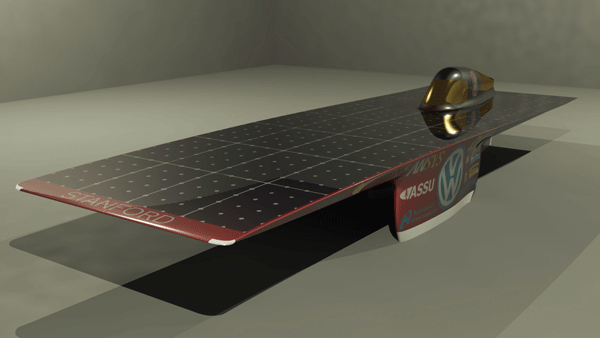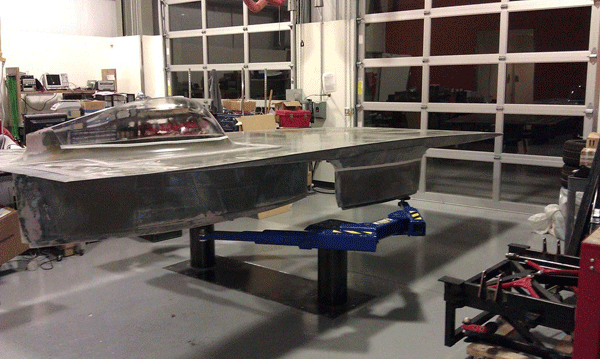
The countdown to our sixth annual Maker Faire Bay Area has begun! This year’s Faire, the world’s largest DIY festival, is taking place on May 21 and 22 at the San Mateo County Fairgrounds south of San Francisco. Mark your calendars, if you haven’t already (and pick up tickets at a discount). At the core of every Maker Faire are the amazing makers who bring their projects and enthusiasm to share. This is the first in a series of interviews profiling some of these inspirational folks. Today we chat with Sam D’Amico of the Stanford Solar Car Project. A rendering of the car their team is working on, named Xenith, is shown above.
Before we get started with the interview, here are the team’s predicted specs for Xenith:
5 meters long, 1.5 meters wide
150V battery pack
1300W SunPower solar array
Mass: 150kg-180kg (we will know once the car is assembled completely)
Estimated maximum speed: 80-90 miles per hour
Estimated solar cruise speed: 50-60 miles per hour
Range without sunlight: several hundred miles
1. What is the Stanford Solar Car Project. When was it started and what is the goal?
The Stanford Solar Car Project is an undergraduate student group at Stanford University dedicated to designing, building, and racing solar-powered electric vehicles in transcontinental competitions. We were founded in 1989 and are currently building our 10th car, which hopefully will be our fastest yet. Our ultimate goal is to win the World Solar Challenge, a 3,000km race from Darwin to Adelaide across the Australian Outback.
2. Tell us about the project you’re bringing to Maker Faire. What inspired your team to make it and how long did it take?
Our tenth car, Xenith is our most aerodynamically advanced car yet. Along with advanced carbon fiber construction, custom electronics, and the next-generation silicon solar array, we’re hoping to be extremely competitive against other student teams such as MIT, Michigan,, and previous winners Tokai University. The car seats one and drives much like a normal car, with a steering wheel, brake, and accelerator pedals.
3. How many people have worked on Xenith? What does your collaboration process look like?
Our team ranges from 15 to 30 people, depending on the time in the school year and the amount of work needed to be done on the car. We approximately divide the team by discipline, but what ends up happening is that people end up working on whatever requires the most manpower at a given time. As an electrical engineering major, I end up doing tasks including electronics design/assembly, software, finance, and even bodywork. We end up having several core members that are well versed on all systems critical to the car, and then a number of people who serve as the point people for specific projects.

4. How did you hear about Maker Faire and why did you decide to participate?
We heard about the Maker Faire since many of us are MAKE subscribers and a couple of us went to the event last year. Since we have a new car, we figured this year was a great opportunity to get more exposure and help promote electric vehicles and clean technology in the process. We would also love to get the Bay Area community aware of our program and promote practical science and engineering education.
5. Is the project strictly a hobby or a budding business?
We’re a non-profit student group at Stanford University comprised entirely of unpaid volunteers. Several companies, however, have spun off our team in recent memory, most notably Tesla Motors.
6. What new idea (in or outside of your field) has excited you most recently?
We’re currently the most excited about our next-generation solar panel technology. We have come up with a technology that is light, smooth, and lets as much light in as possible. In some sense, the technology resembles how modern flat panel displays and phone screens are put together, laminated with a thin sheet of high-strength glass. In this case, we’re looking at potential aerospace applications for the technology due to its relative ease of assembly. The panels will go on the top of the car (as seen in the picture, and are wired to power converters that increase the voltage to be able to charge the battery pack.
7. If your team had a motto, what would it be?
In terms of a motto, we don’t really have one decided for this car yet. Probably something about it being really thin.
8. What advice would you give to the young makers out there just getting started?
Many of us came from a background of experimenting in our homes, taking risks, and voraciously searching for the next great project to try. Going the step from reading about great things to do to actually doing them is perhaps the best way to get started. The next most important factor is to maximize the resources that you have at your disposal, whether they be your parents, friends, or teachers, if you think that your horizons are limited by a lack of tools or technical experience. Also, it’s important to challenge the culture of risk-adverseness — as you will never be amazing at what you do unless you push the boundaries a little too much (and maybe risk your eyebrows getting singed a bit). Your parents will forgive you once you impress the admissions boards of various engineering schools with your practical skills.
Thanks so much, Sam! For more information, check out the team’s blog, which includes a lot of technical documentation. In true maker fashion, Sam said: ” Unlike most other teams we are not particularly secretive. While we hope to win the race, we don’t think we will push technology forward if we act as secretly as a Formula 1 team.” Awesome.
Also be sure to check out their YouTube channel and their Twitter feed. See you at the Faire!
ADVERTISEMENT






